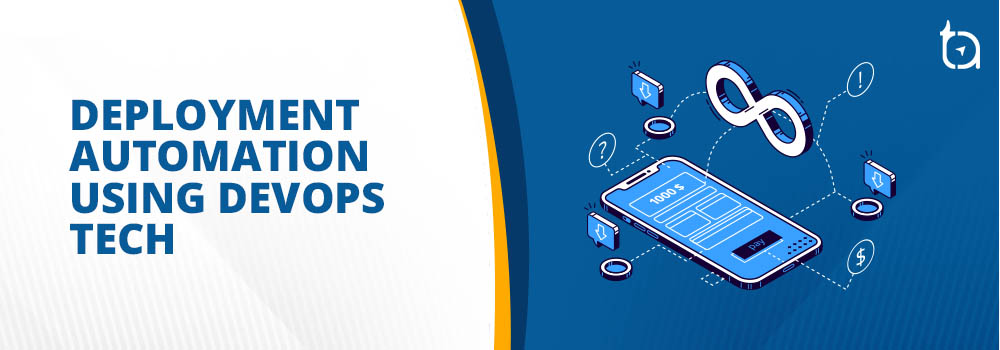Enabling, Measuring, and Improving Deployment Automation Using DevOps for IT Product Companies

Author : John Prabhu 21st Sep 2020

As an IT product company, deployment automation helps your software pass the testing and production environments in less than a minute. Automation is critical to mitigate the production deployment risks. Also, it is crucial when it comes to testing your software and receiving quicker feedback on its quality by allowing testing teams to do quick and thorough testing as soon as the build is deployed.
An Automated Deployment Process has the Following Inputs:
1. Packages created by the Continuous Integration (CI) process.
2. Scripts to customize and configure the environment, deploy the packages, and perform a deployment test.
3. Environment-specific configuration information.
It is a best practice to store the scripts and configuration details in version control. Moreover, your deployment process should download the packages from an artifact repository. Some of the examples of artifact repositories are Container Registry, Nexus, etc.
Your scripts generally perform the below tasks:
1. You can install and configure required software prior to preparing the target environment or start a virtual host from a pre-prepared image in a cloud provider.
2. Deploy the packages.
3. Perform deployment-oriented tasks such as executing database migration scripts.
4. Perform any required configuration.
5. Run a deployment test and make sure all the necessary external services are easily accessible and the system is fully functioning.
How to Implement Deployment Automation?
We recommend you to follow these best practices while designing your automated deployment process:
Use the same deployment process for every environment, including production:
It is important to follow this rule because you test the deployment process itself a number of times before you leverage it to deploy to production.
Enable anyone with required credentials to deploy any version of the artifact to the required environment on demand in a fully automated fashion.
When you depend on someone else to prepare an environment and you create only a ticket, then you don’t have a fully automated deployment process.
Use the same packages for every environment.
It is always a good practice to keep environment-specific configuration separate from packages. Hence, you will be sure that the packages you deployed to production are the same as you tested earlier.
Enable recreating the state of any environment from the information available in version control.
This ensures deployments are repeatable, and in case of emergencies, you can easily store the state of production.
Therefore, you now have a tool that helps you to autonomously make deployments and records the status of builds and respective environments. Also, it records the output of the deployment process for audit purposes. Many Continuous Integration (CI) tools have these features.
Common Pitfalls in Deployment Automation
When you automate your deployment process, you might face the following pitfalls:
- Poor collaboration between teams.
- Poorly designed components that lack automation facilities.
- Complexity of the existing process.
- Dependencies between services.
1. Poor collaboration between teams
This pitfall happens when the IT Operations team and the product development teams are not in sync. For example, the development team might use one type of deployment method; whereas, the IT operations team uses a different one. In addition, the operations team might use a differently configured environment; whereas, the development team might use another differently configured environment. As a result, it creates errors and inconsistencies. Therefore, the development team and IT operations team should work together in creating a deployment automation process. Hence, both the teams can understand, maintain, and evolve the deployment automation process.
2. Poorly designed components that lack automation facilities.
Another common pitfall is the components that are not created with automation in mind. You need to mitigate the processes that require a person to manually log into a console and interact manually to complete a deployment process. In today’s world, most of the cloud service providers offer an API with which your deployment script can complete the task. If your cloud service provider doesn’t offer such services, you might want to figure out the tool’s underlying configuration file or database and make changes to it directly. You can also replace it with another tool that offers API facilities to avoid these manual interventions.
3. Complexity
Automating a manual process, which is also very complex will result in a fragile and complex automated process. Therefore, you need to re-architect for deployability. In other words, you need to simplify the deployment scripts and push the complexities into the application code and infrastructure platform. Try predicting the deployment failure modes and look for ways to avoid them by making your services, components, and infrastructure platform. The ideal process for automating deployment is to run your cloud-native app on a platform-as-a-service such as Cloud Run, Pivotal Cloud Factory, and App Engine. It is because you can easily deploy your app by running a single command and you don’t need any further deployment script.
In a reliable deployment process, there are two important properties you should consider. Firstly, the individual steps of the deployment process should be idempotent. As a result, you can repeat them as many times as you wish in case of failure. Secondly, they should be order independent. In other words, the services and components should not crash in an uncontrolled way if some other service or component, i.e., dependencies are absent. The services should continue to operate in a degraded fashion until the dependencies become available.
It is highly recommended that you implement these principles as system requirements from the beginning of your products and services’ design phase. If you’re trying to automate an already built system, you need to do some internal work to implement these characteristics or build in telemetry. As a result, the deployment process can detect inconsistent states and fail gradually.
4. Dependencies
Another common pitfall is many deployment processes, especially in an enterprise environment demand orchestration. Simply put, you need to deploy multiple services at one go in a particular order simultaneously while you perform other tasks such as database migrations in a synchronized fashion. You might find some enterprise deployment workflow tools that act only as a short-term remedy to this architectural problem: tight coupling between various components and services. An ideal system is something that is capable of deploying services independently without the need for orchestration.
This approach requires proper design to make sure each service supports backward compatibility so that the clients of the service don’t require upgrading in lock-step, but can be upgraded independently when needed. You can easily accomplish this task with the help of API versioning. You must also ensure that service can continue to work seamlessly even if they couldn’t establish a connection with their dependencies. This design is highly suggested for distributed systems because it helps in preventing cascading failures. With the help of parallel change patterns you can also decouple database upgrades from services they depend on.
Ways to Improve Deployment Automation
To have a flawless deployment automation process, you must first document the existing deployment process in a common tool that operations teams and developers have access to. Now, you can ideate to gradually simplify and automate the deployment process. You can accomplish this by following the below tasks:
Package the code suitably for deployment.
Create pre-configured virtual machine images or containers.
Automate the deployment and configuration of middleware.
Copy packages or files into the production environment.
Restart servers, applications, or services.
Generate configuration files from templates.
Run automated deployment tests to ensure the system is functioning and correctly configured.
Run testing procedures.
Script and automate database migrations.
Try to mitigate manual intervention wherever possible and implement idempotence and order independence Also, look for ways to leverage the capabilities of your infrastructure platform. You must also remember that the deployment automation process should be as simple as possible.
Ways to Measure Deployment Automation
Measuring deployment automation is not complex and is rather simple.
1. Identify the number of manual steps involved in your deployment process. Take time to work on reducing these steps. Higher the number of manual steps the higher is the deployment time and opportunity for error.
2. Calculate the percentage of automation implemented in your deployment cycle and try to increase the percentage further.
3. Analyze the time delays in the deployment pipeline. Understand why and where the code deployment gets stalled and work on reducing those delays.
Final Thoughts
Deployment automation is crucial because you need to quickly deploy your code to testing and production environments for quicker launch of your product. If there are a lot of manual interventions required in pushing your code to the testing and production environments, then there is a wide scope for error and delays. Measure your deployment automation process and work on mitigating the risks associated with it.
We, at TechAffinity, have collaborated with IT product companies ranging from startups to F500s and have successfully launched many apps to the Google Play and Apple App Stores. Our product development team and operations team are already familiar with the deployment automation process and they can seamlessly push your code to testing and production environments. Feel free to send your queries to media@techaffinity.com or schedule a call with our experts.
